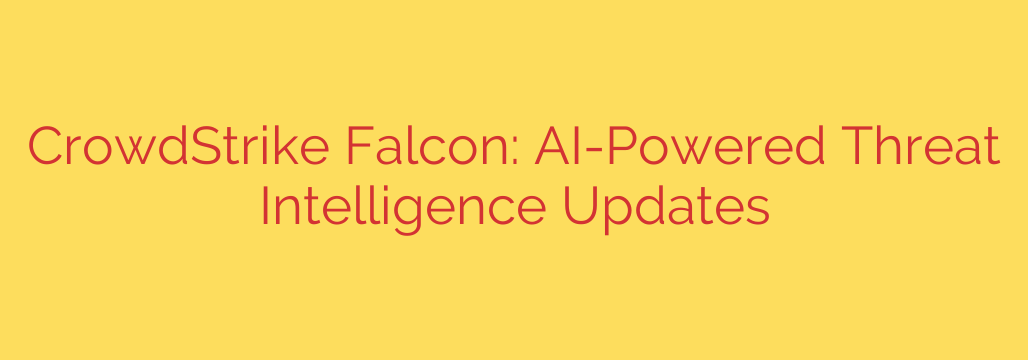
Unleashing AI: How Next-Generation Threat Intelligence is Reshaping Cybersecurity
In the relentless battle against cybercrime, security teams are often overwhelmed. The sheer volume and sophistication of modern threats make it nearly impossible for human analysts to keep pace using traditional methods alone. Yesterday’s security alerts are no longer sufficient to protect against tomorrow’s attacks. This is where the paradigm shifts—from reactive defense to proactive, AI-powered threat intelligence.
The future of cybersecurity isn’t just about building higher walls; it’s about developing smarter defenses that can predict, identify, and neutralize threats before they can cause damage. By harnessing the power of artificial intelligence, organizations can transform their security posture from a state of constant reaction to one of confident control.
The Limitations of Traditional Threat Intelligence
For years, cybersecurity has relied on Indicators of Compromise (IOCs)—static data points like malicious IP addresses, file hashes, or domain names. While useful, this approach has a fundamental flaw: it’s entirely reactive. An IOC is only generated after an attack has been identified somewhere in the world. By the time you add it to your blocklist, sophisticated adversaries have likely already changed their tactics and infrastructure, rendering the intelligence obsolete.
This outdated model leaves security teams perpetually one step behind, sifting through a mountain of low-context alerts and struggling to distinguish real threats from false positives.
The AI-Powered Advantage: Proactive and Predictive Defense
Modern threat intelligence, supercharged by AI, moves beyond simple IOCs to focus on Indicators of Attack (IOAs)—the subtle behaviors and techniques that reveal an attacker’s intent. Instead of just identifying the “what,” this approach uncovers the “how” and “why” of an attack, enabling a far more effective defense.
Here’s how AI is revolutionizing the field:
Predictive Threat Detection: AI algorithms analyze trillions of data points from endpoints across the globe in real-time. By identifying patterns and correlating seemingly unrelated events, the system can predict attacks before they are even launched. It recognizes the early-stage techniques of adversary tradecraft, allowing defenses to engage long before a malicious payload is delivered.
Unmatched Speed and Scale: No human team can process information at the speed of a machine. AI-powered platforms can instantly analyze vast datasets to identify novel threats, automating the entire process from detection to response. This means defenses are updated globally in seconds, not hours or days.
Rich, Contextual Intelligence: An AI-driven system doesn’t just send an alert; it provides a full narrative. It can attribute an attack to a specific adversary group, detail the tactics and techniques used, and explain the potential impact. This rich context empowers security analysts to make faster, more informed decisions.
Automated Protection and Threat Hunting: When a new threat is identified, an AI-powered security platform can automatically generate and deploy new protections across all endpoints. Furthermore, it can proactively hunt for similar IOAs within your environment, ensuring no trace of the adversary remains hidden.
The Role of Generative AI in Modern Security
Generative AI is taking this a step further by making sophisticated security insights accessible to analysts of all skill levels. Instead of complex queries, security professionals can ask natural language questions like, “Show me all activity related to the latest ransomware variant” or “Summarize the attack path on this compromised server.”
This technology dramatically reduces the time needed for investigation, automates the creation of detailed incident reports, and provides clear, actionable response recommendations. It acts as a force multiplier, allowing security teams to operate more efficiently and effectively.
How to Strengthen Your Security Posture Today
Staying ahead of advanced adversaries requires a modern approach. Here are actionable steps to enhance your organization’s defenses:
Shift from Reactive to Proactive: Move beyond legacy antivirus and IOC-based tools. Invest in a platform centered on Endpoint Detection and Response (EDR) and Extended Detection and Response (XDR) that uses behavioral AI to stop threats.
Prioritize Contextual Intelligence: Don’t just collect alerts. Ensure your security solution provides deep context on who the attacker is, what they want, and how they are trying to achieve their goals.
Embrace Automation: Use security tools that can automate detection, prevention, and response. This frees up your security team to focus on strategic initiatives and high-level threat hunting rather than manual, repetitive tasks.
Adopt a Unified Security Platform: Consolidate your security tools onto a single, integrated platform. This eliminates security gaps, reduces complexity, and provides a single source of truth for all threat activity.
The cyber threat landscape will only continue to grow in complexity. Organizations that embrace the power of AI-driven threat intelligence will not only survive—they will thrive, staying miles ahead of their adversaries in the ongoing cybersecurity arms race.
Source: https://datacenternews.asia/story/crowdstrike-unveils-ai-driven-updates-to-falcon-threat-intelligence







